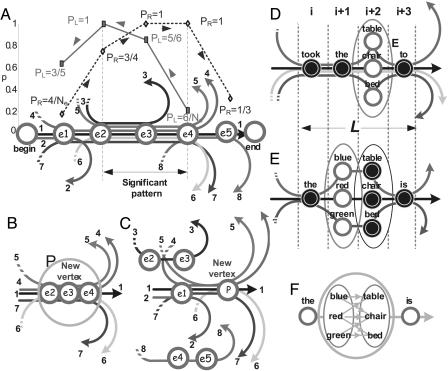Fig. 1.
The graph structures used by the MEX and adios algorithms. (A) The search path no. 1 (begin → e1 →... → e5 → end) is rendered as a solid black line connecting the special begin and end vertices. Four other paths (nos. 4, 5, 6, and 7) join it along the vertices e2, e3, e4, thus forming a bundle that may constitute a significant pattern subject to the MEX criterion described in BOX 1: The MEX Procedure. Values of PR and PL, originating at e1 and e4, respectively, are displayed for the example shown here. (B) A significant pattern (P = e2 → e3 → e4) has been identified. (C) A new vertex is added to the graph, replacing the elements subsumed by P. Paths that belong to sequences not subsumed by it, such as no. 3 here, are left untouched. (D) The path is generalized: the algorithm picks among the set of path segments encountered in a window of size L = 4 those that differ in a single slot and are embedded in a common context (the relevant vertices are marked by open circles). The vertices in this slot form an equivalence class E to be treated as a single unit, resulting in the first generalization step (see BOX 2: Theadios Algorithm). (E) The just-detected E(i + 2) is used to find an additional equivalence class; it is specific to the current common context, thus enhancing the safety of generalization. (F) Stacking two equivalence classes leads to further generalization (see BOX 2: The adios Algorithm for details).

